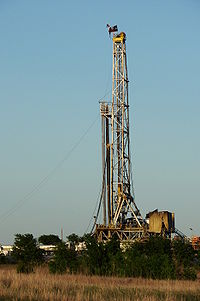
Photo from wikipedia
Abstract Chemical-looping combustion (CLC) technology can play a significant role in decreasing costs for CO2 capturing in the future. The technology relies on the use of an oxygen carrier (OC)… Click to show full abstract
Abstract Chemical-looping combustion (CLC) technology can play a significant role in decreasing costs for CO2 capturing in the future. The technology relies on the use of an oxygen carrier (OC) material, which becomes a solid waste material after it is deactivated. The aim of this study was to verify the possibility to produce high-strength ceramic proppants from a spent Cu-based OC, consisting mainly of α-Al2O3 and a minor content of CuAl2O4. Experiments were carried out with both pure α-Al2O3 and a spent Cu-based OC delivered from a pilot CLC plant. Milling, granulation and sintering were the main process steps developed in the study. The results clearly demonstrated the technical feasibility to use a Cu-based spent OC as a raw material for producing high-strength ceramic proppants. After milling for 1 min, granulation and sintering at 1400 °C, ceramic particles with a compressive strength > 100 MPa and a sphericity of 0.9 were obtained. Further increasing the sintering temperature to 1600 °C enabled to reach compressive strengths > 150 MPa. At this sintering temperature the CuAl2O4 melted and separated from the solid ceramic spheres.
Journal Title: Ceramics International
Year Published: 2017
Link to full text (if available)
Share on Social Media: Sign Up to like & get
recommendations!